Does Banana Bread Need to Be Refrigerated? (How to Store It)
Here’s all you need to know about storing banana bread. Learn whether you should refrigerate it, how to wrap it, and how to go about freezing it.
So you baked or bought banana bread, cut a couple of slices (or ate half of it), and you’re wondering what you should do with the rest.
How do you store banana bread? Do you refrigerate it or leave it at room temperature? Can you freeze any excess?
Do those questions sound familiar?
If so, this article is for you. Let’s dive right in.
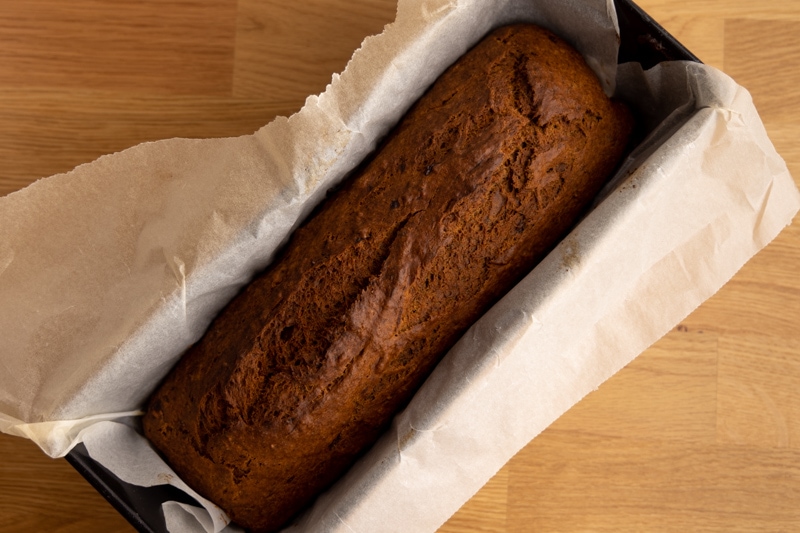
Does Banana Bread Need to Be Refrigerated?
You should refrigerate banana bread if you want it to last for more than 3 to 4 days or after cutting into it if it has some unmashed banana pieces inside. Make sure it’s sealed tightly so it doesn’t pick up any smells or dry out in the fridge.
In general, banana bread doesn’t require refrigeration when stored for the short term – plain banana bread lasts 3 to 4 days on the counter. But if you decide to make it a bit fancier and leave some of the banana pieces unmashed for extra flavor, that’s when the need for refrigeration kicks in.
Unmashed fruit can grow mold quite quickly at room temperature, so moving that banana bread to the fridge will help it stay safe to eat for longer. You do the same for other (somewhat) similar baked goods, e.g., apple pie.
Related: Does apple pie have to be refrigerated?
And if you decide to top your banana bread with banana halves or slices, refrigerate it from the get-go. The same applies to other perishable toppings, such as cream cheese frosting and the like.
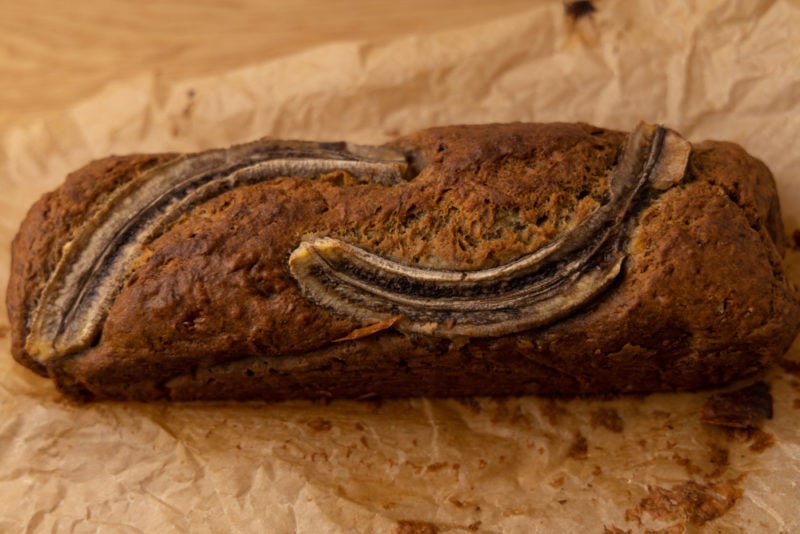
How to Store Banana Bread in the Fridge?
Once your banana bread cools to about room temperature, place it in an airtight container or freezer bag, seal it, and refrigerate. If it’s an extra moist loaf, place a paper towel underneath and leave some breathing room on top so the extra moisture doesn’t end up on the bread’s surface.
That’s the gist of it.
Letting the bread cool before storage is super important, as that’s when extra moisture evaporates. That ensures you don’t end up with a soggy bottom, and there’s not too much condensation you have to take care of.
But if it’s a super moist banana bread, which isn’t all that common, paper towels and a bit of breathing room will help you deal with the extra condensation. If that’s the case, replace the towels and wipe the bag or container lid when wet.
Despite what some articles out there suggest, refrigerating banana bread isn’t that bad. The main issue often pointed out is the bread drying prematurely, which can be easily fixed by sealing it tight. Which is what we do anyway.
Plus, many recipe bloggers also recommend refrigerating banana bread if you need it to last longer than a few days.
In other words, if you keep the bread sealed, it won’t dry out or pick up any smells. And if you notice any condensation after a day or two of refrigeration, remove the water droplets using a kitchen towel.
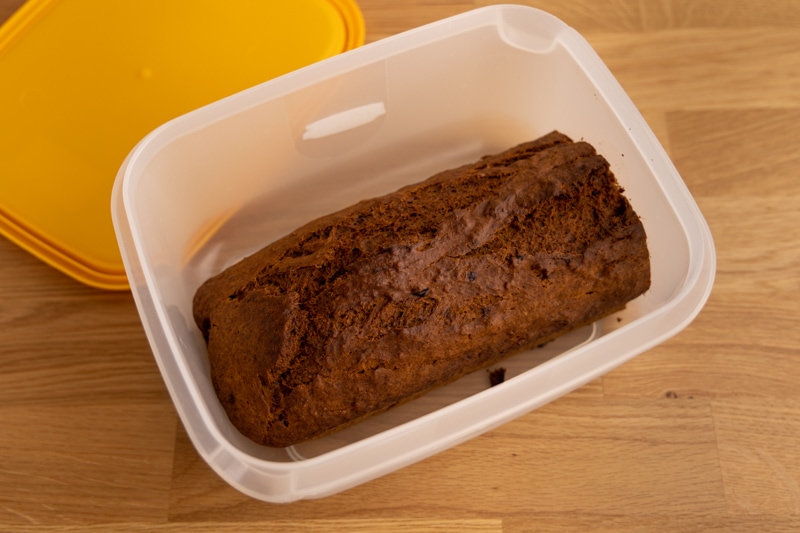
How to Store Banana Bread at Room Temperature?
The best way to store banana bread is to place it in an airtight container or freezer bag once it’s completely cool and leave it sealed at room temperature for 3 to 4 days. If you need more time, you should refrigerate or freeze it.
As is the case when refrigerating banana bread, it’s important to let the loaf cool before storage so that all the excess moisture can escape.
If you skip that step, you will end up with soggy bread or lots of water drops (due to condensation) in the container or bag. And those droplets can cause mold growth. Mold loves the combination of room temperature and high humidity.
Now, if your banana bread is super moist (lots of bananas, not that much flour), consider placing a paper towel under the loaf in the container or bag. It will catch any water droplets that might form and prevent the bread from soaking them.
Again, that’s only necessary if your banana bread is moist and you often have condensation issues.
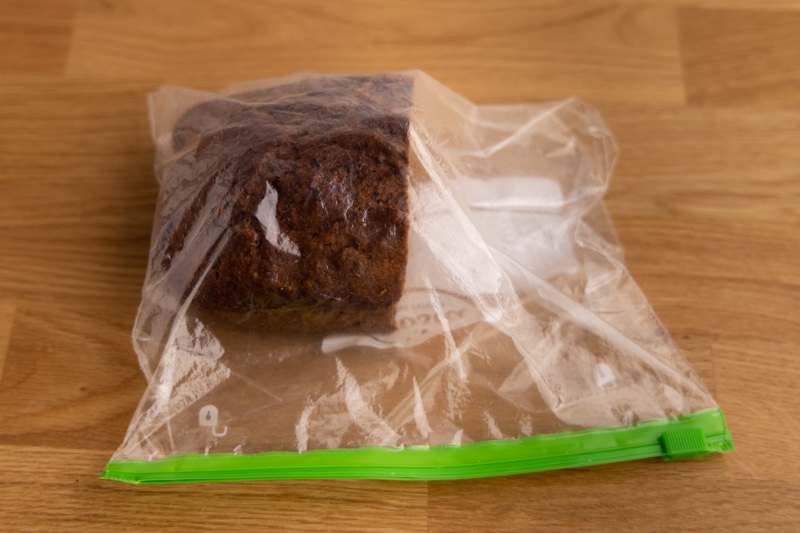
Can You Freeze Banana Bread?
Freezing is a great way to store banana bread for a prolonged period. It freezes beautifully, just like regular bread does.
To freeze banana bread, you should:
- Let the bread cool. No matter if you want to store your banana bread on the counter or in the freezer, it needs to cool down first.
- Slice it if you want. Slicing the bread allows you to quickly grab a slice or two from the freezer without having to defrost the whole thing. If you’re freezing an entire loaf, slicing it is definitely worth considering. But if you just need the leftovers to last a couple of extra days, feel free to leave the piece whole.
- Wrap your banana bread. If you plan on freezing it only for a week or two, just putting it in a freezer bag should be enough. But if you want to freeze it for longer, it needs better protection against freezer burn. That’s when it makes sense to first wrap it tightly in plastic wrap or aluminum foil and then place it in a freezer bag. Two layers of protection against cold air should be enough to protect the bread for a few months.
- Freeze it. Once everything above is done, it’s time to chuck the bread in the freezer and leave it there until you’re ready to eat it.
Banana bread retains quality for at least 3 to 4 months in the freezer.

How to Defrost
When it comes to defrosting, you can:
- transfer the loaf to the fridge for at least a couple of hours (or overnight)
- take out a few slices and leave them on the counter for half an hour; prepare and eat immediately
- toast it in a toaster, on a hot place, frying pan, or under a grill
The last option takes only a couple of minutes, so there’s no need to remember about thawing the bread in advance.
Rotten Records: Share Your Snap!
Caught some food past its prime? Upload your photo to “Rotten Records” and help others spot the signs of spoilage. Every image makes our food community safer and more informed!
![Can You Freeze Zucchini Bread? [Yes, Here’s How]](https://www.doesitgobad.com/wp-content/uploads/Frozen-zucchini-bread-768x512.jpg)
![Does Hot Chocolate Expire? [Shelf Life, Storage, and Expiration]](https://www.doesitgobad.com/wp-content/uploads/Two-cups-of-hot-chocolate-768x512.jpg)
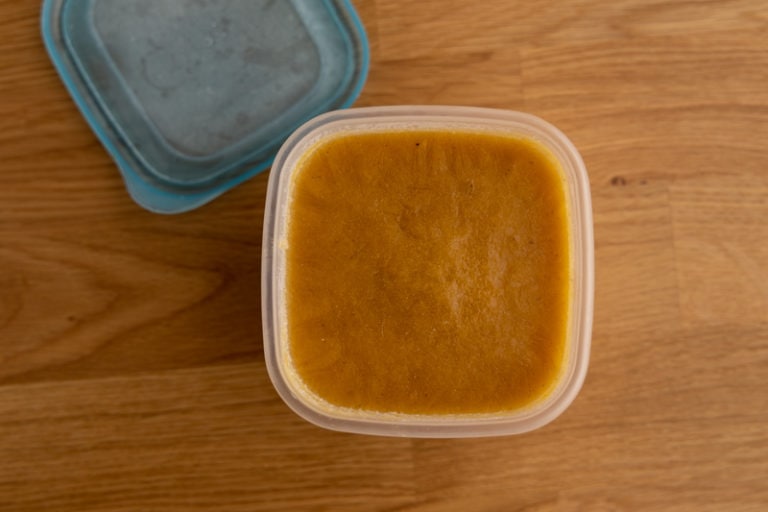


![Does Brown Sugar Go Bad? [Shelf Life, Expiration, Hardening]](https://www.doesitgobad.com/wp-content/uploads/Brown-sugar-closeup-768x512.jpg)